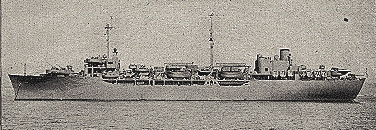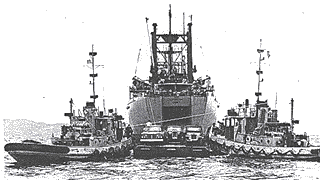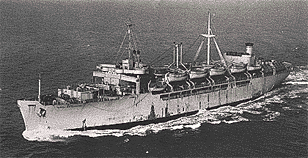"Operations Other Than War" for Military Sea Transportation Service and Military Sealift Command
By Salvatore R. Mercogliano
When USNS Bob Hope and Soderman arrived at Thessalonki, Greece during the summer of 1999, they offloaded elements of the Army's 1st Infantry Division for peacekeeping duty in Kosovo. While this operation involvement the movement of large quantities of combat material, it was not intended for these forces to go into action. Instead, they were performing a mission that has become fairly commonplace in the last few years. In military parlance it is known as Operations Other Than War (OOTW), using military forces not for their specific war fighting capability, but to perform policing and or other duties as directed by the President.
Over its entire history, Military Sealift Command, and its precursor, Military Sea Transportation Service, were heavily involved in similar functions, although they lacked this distinctive title.
Early Involvement in Vietnam
When MSTS met its initial baptism of fire off the shores of Korea in 1950, the service chartered a large number of Liberty ships to carry tanks, trucks, guns, ammunition, food, and other equipment across the Pacific. However their destination was not Pusan, but two ports on the Red and Soirap Rivers -- Haiphong and Saigon. The ships were delivering Mutual Defense Assistance Program (MDAP) material for the French in their struggle against the Viet Minh.
Not all the ships were met with a warm reception. In 1951, the aircraft transport USS Windham Bay (T-CVE 92), one of five Navy-manned escort carriers operated under the direction of MSTS, arrived at Saigon to offload a cargo of ex-Navy F8F Bearcat fighters. Following a five-and-a-half hour transit up the river, the ship arrived pierside and discharged its aircraft. However that first evening, the ship was attacked and targeted with about 17 hand grenades from pro-Viet Minh personnel on the pier. Although no damage or casualties were recorded, it was a fateful omen for America's involvement in Vietnam.
In the fall of 1954, MSTS ships responded to another mission in Vietnam, when ships from the nucleus fleet sailed to Haiphong to help relocate thousands of displaced refugees to the south following the signing of the Geneva Accords that separated the nation at the 17th parallel. Operation Passage to Freedom involved Navy amphibious vessels, MSTS transports, and wide array of commercially chartered vessels.
USNS Marine Adder, a C-4 transport, made a total of 6 trips over a period of 4 months. During the course of these voyages, cooks onboard served over 82,000 pounds of rice and 39,000 pounds of codfish, while the medical staff supervised the delivery of 14 babies. Not be outdone, USNS General R. L. Howze, led the pack with a total of 38 births on board. All told, Navy, MSTS, and merchant marine shipping relocated over 300,000 Vietnamese to the south, along with 70,000 tons of equipment and 8,000 vehicles.
USNS General R. L. Howze C4-S-A1 Troopship (c.1945)Crisis in Lebanon
Perhaps the first true OOTW crisis that MSTS responded to was America's intervention in Lebanon in July 1958. That month, a coup in Iraq overthrew the pro-Western royal family, and would ultimately lead to the rise of Saddam Hussein. The government in Lebanon requested US assistance in preventing a similar occurrence. This became the first American contingency operation of the Cold War. It was initially accomplished by Marines, however, they required additional reinforcements and supplies. While airlift provided the initial sustainment, sealift was needed to transport the bulk of the follow-on forces.
MSTS responded within hours by diverting the freighter USNS Dalton Victory from its scheduled North Atlantic run to load elements of the US Army out of Germany for shipment to the Middle East. The service diverted the transports USS General Randall, USNS Geiger, and USNS Upshur to ports in France to load 6,500 troops. MSTS also used its newest vessel, USNS Comet the first Roll-On/Roll-Off ship to transport over 10,000 measurement tons of cargo, from Bremerhaven to Beirut.
Transferring jeeps and trucks from USNS Comet to a lighterIn addition to utilizing nucleus ships, MSTS solicited the commercial industry to support the military. Commenting on their response, then Commander of MSTS, Vice Admiral John M. Will stated, "The American flag lines cooperated 100 percent . . . The Military Sea Transportation Service was ready . . . thanks to the selfless loyalty and the high standards of performance shown by the dedicated and skilled personnel of this command."
Crisis in Congo
In 1961, MSTS once again responded to another contingency, this time in support of the United Nations. In post-colonial Africa, the nation of Congo was engulfed in civil war, with rebels threatening to separate the mineral-rich region of Katanga from the rest of the nation. The UN ordered in troops to quell the disturbance and asked the United States to provide the necessary sealift.
Vice Admiral Roy A. Gano dispatched Lieutenant Commander Robert Burns, from his post as MSTS representative in Toledo, Ohio, to establish the first MSTS office south of the equator -- Matadi, Congo Republic. To support this operation, Gano activated two laid-up C-4 transports, USNS General Blatchford and General Eltinge. However after the initial voyage of Blatchford, Congolese rebels closed the port to shipping and forced a diversion to Mombassa, Kenya, on the opposite coast of Africa, as an alternative debarkation point. For over two years -- February 1961 to July 1963 -- MSTS transported over 43,500 troops to and from duty in war-torn Congo.
USNS General Blatchford C4 TroopshipCuban Missile Crisis
One of the best examples of the utility of MSTS in OOTW came in 1962, when the world was brought to the brink of a nuclear confrontation between the superpowers over the staging of intermediate range ballistic missiles on the island of Cuba.
Early on October 18th of that year, the transport USNS Upshur arrived at Guantanamo Bay from New York, Norfolk, and San Juan, enroute to Panama. The ship was making its scheduled run through the Caribbean, transferring military personnel and dependents. The ship's scheduled departure was delayed due to an announced engineering casualty. In reality, the base commander was holding the vessel till he could organize the evacuation of all non-essential personnel due to the proposed blockade of Cuba by order of President John F. Kennedy. Late in the afternoon of October 22, Upshur, loaded with 1,725 women, children, and civilian employees, set sail, along with two other naval vessels, getting these non-combatants out of harm's way.
Admiral Gano used this example to emphasize the raison d'être for his command. This "immediate capability in an emergency" was reinforced by the diversion of MSTS nucleus vessels and chartered ships to key sites in the United States, to create a credible conventional force deterrence to the Soviets and also a vital demonstration of Military Sea Transportation Service's capabilities to the military.
Post-Soviet Crises
It is in the past decade that OOTW has emerged as a major mission for the Military Sealift Command. With the end of the Cold War, the primary assignment to support the U.S. military in an armed confrontation with the Soviet Union seemed to disappear, but new threats and contingencies began to emerge almost immediately.
In late 1992, the United States led a United Nations force into Somalia, in east Africa, to aid in the distribution of food and relief supplies and consequently became immersed in nation building. On December 9, 1992, as part of Task Force 155, the Maritime Prepositioning Ship (MPS) MV 1st Lt. Jack Lummus began splashing part of its cargo of marine amphibious assault vehicles to secure the port of Mogadishu. Two days later, Lummus, under the command of Captain Harry Vanderploeg, entered the port and became the first American ship to offload as part of Operation Restore Hope.
At nearly the same time, while ships of the Afloat Prepositioning Force at Diego Garcia, and Fast Sealift Ships along the East Coast of the United States were sailing for Mogadishu, two other American freighters were involved in another OOTW. MV American Eagle and American Falcon sailed from the port of Montreal to transport replacement equipment for Canadian peacekeepers stationed in Bosnia-Herzegovina. This mission was repeated in 1995 when the British requested MSC's help in conveying a brigade of troops for use as a Rapid Reaction Force in Croatia.
The command activated two RO/RO's -- MV Cape Race and Cape Diamond -- from the Ready Reserve Force. Later that year, one other ship -- MV Cape Rise -- was broken-out to help transfer NATO equipment to Bosnia as part of the Dayton Peace Accords.
Ships of the Military Sealift Command continue to support a wide range of OOTW. In late October 1998, following the disaster brought to Central America by Hurricane Mitch, MSC mobilized a massive sealift operation to bring humanitarian relief to the people of Honduras, Nicaragua, and Guatemala.
Other ships of the command have been involved in rescues at sea, the periodic change-outs of American units in Bosnia and Kosovo, assisting in the recovery of downed aircraft. All these missions, which the Defense Department has been ordered to perform, has expanded the roles and responsibilities of the Military Sealift Command and have once again demonstrated the viability of having an "immediate capability" for an emergency, as Admiral Gano stated nearly forty years ago.
Illustrations from:
Troopships of World War II, Roland W. Charles, Washington, DC: The Army Transportation Association, 1947
Sealift, October 1974, Military Sealift Command
From America to United States: The History of the long-range Merchant shipbuilding Programme of the Unites States Maritime Commission (1937-1952) Part 2, L.A. Sawyer and W.H.Mitchell London: World Ship Society, 1981
www.USMM.org is grateful to Professor Salvatore R. Mercogliano for providing this article. Mercogliano is writing his doctoral dissertation about the history of the Merchant Marine, Military Sea Transportation Service, and Military Sealift Command.MSC Ships that Wait by Salvatore R. Mercogliano
11/29/00
www.USMM.org ©1998, 1999, 2000 Salvatore R. Mercogliano and. You may quote material on this web page as long as you cite American Merchant Marine at War, www.usmm.org, as the source. You may not use more than a few lines without permission. If you see substantial portions of this page on the Internet or in published material please notify usmm.org @ comcast.net


